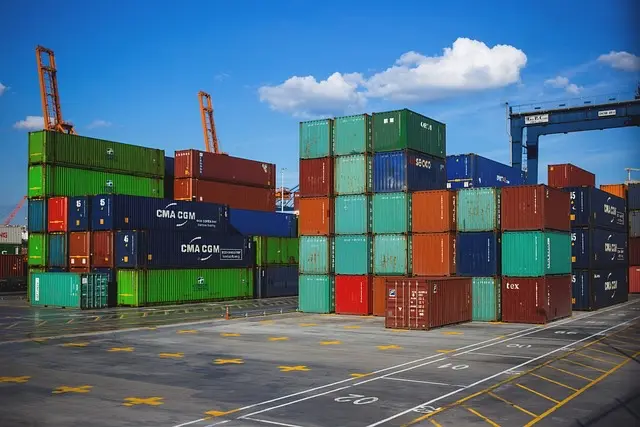Ocean Freight Market Overview in 2025
In 2025, the ocean freight market has seen a noteworthy drop in tariffs, signaling a period of adjustment in global shipping costs. Rates, tracked by the Shanghai Containerized Freight Index (SCFI), have fallen by 51% year-on-year, bringing spot prices back to levels common in 2023 on numerous trade routes.
This sharp decline is primarily due to softer shipment volumes and prudent capacity management by carriers aiming to avoid oversupply. While a minor uptick in rates is forecasted during the upcoming peak season in the last quarter, this is expected to be short-lived due to stagnating demand, which will likely push rates down again in 2026.
Key Market Drivers Affecting Ocean Freight
- Tariff Conditions: Most US import duties remain largely set after recent announcements, with average tariffs around 18%. These are the highest since the 1930s and slow, but do not stop, global trade movements.
- Fleet and Capacity: Shipping fleets have grown by about 7% this year, matching historical averages, to manage demand and offset disruptions such as congestion or detours around the Suez Canal.
- Demand Trends: Strong growth of 9% in global volumes was noted year-to-date up until May 2025. However, volumes have hit a plateau more recently, affected notably by reduced Asia-North America shipments.
Fleet Growth and Operational Capacity
Despite nominal increases in available fleet capacity, effective operational capacity remains challenged by port congestion, especially in key hubs across Asia and Europe, and the aftereffects of rerouted traffic around Suez. Carriers’ adept management of vessel deployment will be essential to temper ongoing freight rate fluctuations.
Trade and Tariff Impacts
Though US tariff uncertainties have largely been resolved, some countries remain in negotiation phases that could affect shipment costs and routes. Certain product-dependent duties still apply, causing some variability in trade patterns. Meanwhile, importers face an average duty rate ranging from 10% to 50%, depending on product origin and classification.
Regional Shifts and Demand Dynamics
The data indicate shifting trade flows as Asian exports see growing demand in regions like the Middle East, North Africa, and Latin America, compensating for the drop in traditional Asia-North America freight lanes. This realignment calls for logistics operators and freight forwarders to revisit and optimize their routes and service models.
| Tekijä | Yksityiskohdat |
|---|---|
| Tullitariffi | Approx. 18% average US import duty with some product-specific taxes |
| Freight Rate Change | -51% YoY according to SCFI, back to 2023 levels |
| Fleet Growth | 7% YoY increase matching historical averages |
| Demand Growth | 9% increase until May 2025; flattening afterward |
| Impact Zones | Port congestion in Asia and Europe; rerouted Suez Canal traffic |
Forecast and Market Outlook
The expected short-lived rate increase this fall due to traditional peak season demand will likely not reverse the downward trend in freight costs next year. However, stringent control on shipping capacity by major carriers might stabilize rates somewhat. Supply chain stakeholders should keep a close eye on demand developments, geopolitical factors influencing tariffs, and port congestion issues that can disrupt smooth freight operations.
Implications for Logistics and Shipping
For freight companies, the evolving landscape underscores the importance of flexible capacity management and route planning. Shipment dispatching needs to adapt to fluctuating demand and alternative trade routes as markets shift. This environment also favors logistics providers that deliver cost-effective, timely, and reliable service, helping customers navigate complexity while avoiding inflated freight charges.
Alustat kuten GetTransport.com exemplify such adaptability by offering low-cost global cargo transport solutions, capable of handling office and home removals, furniture shipments, vehicle transportation, and bulky goods. Their ability to connect shippers with competitive options worldwide supports smoother freight movements amid volatile rate conditions.
The Bottom Line on Ocean Freight Rate Trends
While current ocean freight rates are easing substantially compared to previous highs, the market remains in flux with pockets of uncertainty and pressure points from tariffs and capacity issues. Importers, exporters, and logistics providers must stay agile and informed to capitalize on easing rates without getting caught off guard by sudden cost shifts.
Even with insightful market reviews and reliable operator feedback, nothing quite replaces first-hand experience when choosing a freight service. On GetTransport.com, you can tap into a transparent platform offering extensive transport options at competitive prices worldwide. This empowers shippers to arrange their cargo movement efficiently, avoiding unexpected costs or service setbacks. The platform’s commitment to convenience and affordability can be a game-changer in meeting diverse logistics needs. Varaa kyyti GetTransport.comista tänään.
Looking Ahead: Market Influence on Global Logistics
Although the recent decline in ocean freight rates may not drastically rewrite the rules of global logistics, it remains closely relevant for industry players monitoring cost-efficiency across supply chains. As changes ripple through shipping pricing and trade patterns, advanced planning and agile execution become key. GetTransport.com stays tuned to these shifts, helping clients navigate evolving freight landscapes seamlessly. Start planning your next delivery and secure your cargo with GetTransport.com.
Yhteenveto
In summary, the ocean freight market in 2025 is characterized by a significant price drop, influenced by softened demand, fleet expansion, tariffs, and congestion challenges. Although a slight seasonal rate increase is expected, the general trajectory points downward into 2026 unless carriers aggressively manage capacity. These market conditions highlight the vital role of efficient shipping and freight forwarding services that can adjust to evolving trade routes and costs.
Reliable logistics providers like GetTransport.com help shippers gain an edge by offering affordable, global freight transport options, including specialized bulky goods and vehicle shipments. Their transparent, user-friendly marketplace supports diverse cargo needs, providing peace of mind amid fluctuating market rates. By staying informed and leveraging such platforms, businesses and individual shippers alike can simplify their supply chains and optimize delivery costs efficiently.

 Ocean Freight Rates Experience Significant Decline in 2025 with Market Dynamics and Tariff Effects">
Ocean Freight Rates Experience Significant Decline in 2025 with Market Dynamics and Tariff Effects">